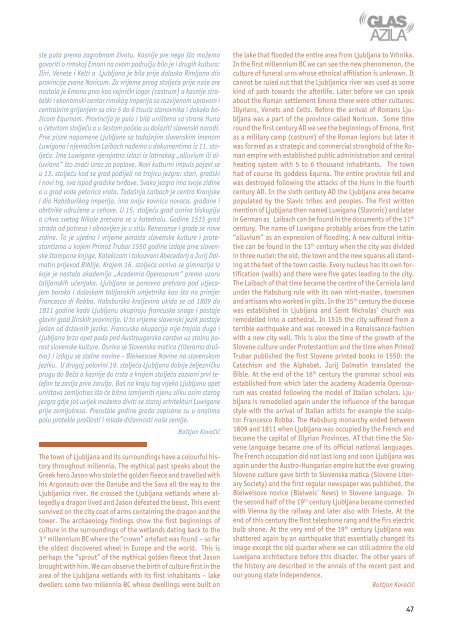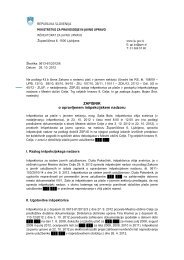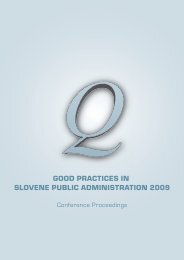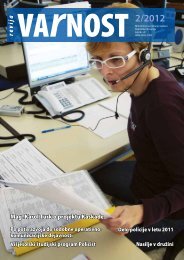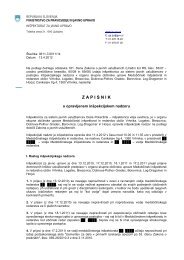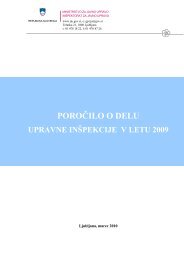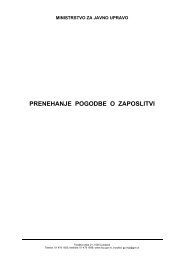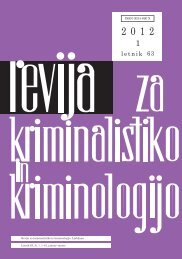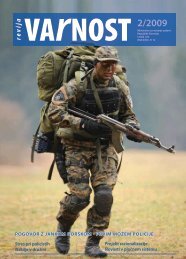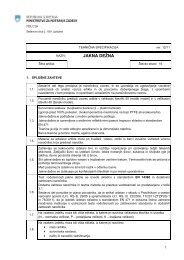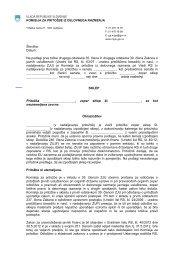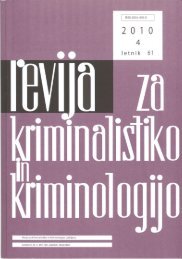glasilo st. 2.indd - Ministrstvo za notranje zadeve
glasilo st. 2.indd - Ministrstvo za notranje zadeve
glasilo st. 2.indd - Ministrstvo za notranje zadeve
Create successful ePaper yourself
Turn your PDF publications into a flip-book with our unique Google optimized e-Paper software.
<strong>st</strong>e puta prema <strong>za</strong>grobnom životu. Kasnije pre nego što možemo<br />
govoriti o rimskoj Emoni na ovom području bilo je i drugih kultura:<br />
Iliri, Venete i Kelti a Ljubljana je bila prije dolaska Rimljana dio<br />
provincije zvane Noricum. Za vrijeme prvog <strong>st</strong>oljeća prije naše ere<br />
na<strong>st</strong>ala je Emona prvo kao vojnički logor (ca<strong>st</strong>rum) a kasnije <strong>st</strong>rateški<br />
i ekonomski centar rimskog imperija sa razvijenom upravom i<br />
centralnim grijanjem sa oko 5 do 6 tisuća <strong>st</strong>anovnika i dakako božicom<br />
Equrnom. Provincija je pala i bila uništena sa <strong>st</strong>rane Huna<br />
u četvrtom <strong>st</strong>oljeću a u še<strong>st</strong>om počela su dolaziti slavenski narodi.<br />
Prve pisne napomene Ljubljane sa tadašnjim slavenskim imenom<br />
Luwigana i njemačkim Laibach nađemo u dokumentima iz 11. <strong>st</strong>oljeća.<br />
Ime Luwigana vjerojatno izlazi iz latinskog „alluvium ili alluviana“<br />
što znači izraz <strong>za</strong> poplave. Novi kulturni impuls pojavi se<br />
u 13. <strong>st</strong>oljeću kad se grad podijeli na trojicu jezgra: <strong>st</strong>ari, gradski<br />
i novi trg, sva ispod gradske tvrđave. Svako jezgro ima svoje zidine<br />
a u grad vode petorica vrata. Tadašnja Laibach je centra Kranjske<br />
i dio Habsburškog imperija, ima svoju kovnicu novaca, građane i<br />
obrtnike udružene u cehove. U 15. <strong>st</strong>oljeću grad osniva biskupiju<br />
a crkva svetog Nikole pretvara se u katedralu. Godine 1515 grad<br />
<strong>st</strong>rada od potresa i obnovljen je u <strong>st</strong>ilu Renesanse i grade se nove<br />
zidine. To je ujedno i vrijeme pora<strong>st</strong>a slovenske kulture i prote<strong>st</strong>antizma<br />
u kojem Primož Trubar 1550 godine izdaje prve slovenske<br />
štampane knjige, Kateki<strong>za</strong>m i takozvani Abecedarij a Jurij Dalmatin<br />
prijevod Biblije. Krajem 16. <strong>st</strong>oljeća osniva se gimnazija iz<br />
koje je na<strong>st</strong>ala akademija „Academia Operosorum“ prema uzoru<br />
talijanskih učenjaka. Ljubljana se ponovno pretvara pod utjecajem<br />
baroka i dolaskom talijanskih umjetnika kao što na primjer<br />
Francesco di Robba. Habsburška kraljevina ukida se od 1809 do<br />
1811 godine kada Ljubljanu okupiraju francuske snage i po<strong>st</strong>aje<br />
glavni grad Ilirskih provincija. U to vrijeme slovenski jezik po<strong>st</strong>aje<br />
jedan od državnih jezika. Francuska okupacija nije trajala dugo i<br />
Ljubljana brzo opet pada pod Au<strong>st</strong>rougarsko car<strong>st</strong>vo uz <strong>st</strong>alnu pora<strong>st</strong><br />
slovenske kulture. Osniva se Slovenska matica (literarno društvo)<br />
i izdaju se <strong>st</strong>alne novine – Bleiwesove Novine na slovenskom<br />
jeziku. U drugoj polovini 19. <strong>st</strong>oljeća Ljubljana dobije željezničku<br />
prugu do Beča a kasnije do tr<strong>st</strong>a a krajem <strong>st</strong>oljeća <strong>za</strong>zvoni prvi telefon<br />
te <strong>za</strong>sija prva žarulja. Baš na kraju tog vijeka Ljubljanu opet<br />
uništava zemljotres što će bitno izmijeniti njenu sliku osim <strong>st</strong>arog<br />
jezgra gdje još uvijek možemo diviti se <strong>st</strong>aroj arhitekturi Luwigane<br />
prije zemljotresa. Preo<strong>st</strong>ale godine grada <strong>za</strong>pisane su u analima<br />
polu protekle prošlo<strong>st</strong>i i mlade državno<strong>st</strong>i naše zemlje.<br />
Boštjan Kovačič<br />
The town of Ljubljana and its surroundings have a colourful hi<strong>st</strong>ory<br />
throughout millennia. The mythical pa<strong>st</strong> speaks about the<br />
Greek hero Jason who <strong>st</strong>ole the golden fleece and travelled with<br />
his Argonauts over the Danube and the Sava all the way to the<br />
Ljubljanica river. He crossed the Ljubljana wetlands where allegedly<br />
a dragon lived and Jason defeated the bea<strong>st</strong>. This event<br />
survived on the city coat of arms containing the dragon and the<br />
tower. The archaeology findings show the fir<strong>st</strong> beginnings of<br />
culture in the surroundings of the wetlands dating back to the<br />
3 rd millennium BC where the “crown” artefact was found – so far<br />
the olde<strong>st</strong> discovered wheel in Europe and the world. This is<br />
perhaps the “sprout” of the mythical golden fleece that Jason<br />
brought with him. We can observe the birth of culture fir<strong>st</strong> in the<br />
area of the Ljubljana wetlands with its fir<strong>st</strong> inhabitants – lake<br />
dwellers some two millennia BC whose dwellings were built on<br />
the lake that flooded the entire area from Ljubljana to Vrhnika.<br />
In the fir<strong>st</strong> millennium BC we can see the new phenomenon, the<br />
culture of funeral urns whose ethnical affiliation is unknown. It<br />
cannot be ruled out that the Ljubljanica river was used as some<br />
kind of path towards the afterlife. Later before we can speak<br />
about the Roman settlement Emona there were other cultures:<br />
Illyrians, Venets and Celts. Before the arrival of Romans Ljubljana<br />
was a part of the province called Noricum. Some time<br />
round the fir<strong>st</strong> century AD we see the beginnings of Emona, fir<strong>st</strong><br />
as a military camp (ca<strong>st</strong>rum) of the Roman legions but later it<br />
was formed as a <strong>st</strong>rategic and commercial <strong>st</strong>ronghold of the Roman<br />
empire with e<strong>st</strong>ablished public admini<strong>st</strong>ration and central<br />
heating sy<strong>st</strong>em with 5 to 6 thousand inhabitants. The town<br />
had of course its goddess Equrna. The entire province fell and<br />
was de<strong>st</strong>royed following the attacks of the Huns in the fourth<br />
century AD. In the sixth century AD the Ljubljana area became<br />
populated by the Slavic tribes and peoples. The fir<strong>st</strong> written<br />
mention of Ljubljana then named Luwigana (Slavonic) and later<br />
in German as Laibach can be found in the documents of the 11 th<br />
century. The name of Luwigana probably arises from the Latin<br />
“alluvium” as an expression of flooding. A new cultural initiative<br />
can be found in the 13 th century when the city was divided<br />
in three nuclei: the old, the town and the new squares all <strong>st</strong>anding<br />
at the feet of the town ca<strong>st</strong>le. Every nucleus has its own fortification<br />
(walls) and there were five gates leading to the city.<br />
The Laibach of that time became the centre of the Carniola land<br />
under the Habsburg rule with its own mint-ma<strong>st</strong>er, townsmen<br />
and artisans who worked in gilts. In the 15 th century the diocese<br />
was e<strong>st</strong>ablished in Ljubljana and Saint Nicholas’ church was<br />
remodelled into a cathedral. In 1515 the city suffered from a<br />
terrible earthquake and was renewed in a Renaissance fashion<br />
with a new city wall. This is also the time of the growth of the<br />
Slovene culture under Prote<strong>st</strong>antism and the time when Primož<br />
Trubar published the fir<strong>st</strong> Slovene printed books in 1550: the<br />
Catechism and the Alphabet. Jurij Dalmatin translated the<br />
Bible. At the end of the 16 th century the grammar school was<br />
e<strong>st</strong>ablished from which later the academy Academia Operosorum<br />
was created following the model of Italian scholars. Ljubljana<br />
is remodelled again under the influence of the baroque<br />
<strong>st</strong>yle with the arrival of Italian arti<strong>st</strong>s for example the sculptor<br />
Francesco Robba. The Habsburg monarchy ended between<br />
1809 and 1811 when Ljubljana was occupied by the French and<br />
became the capital of Illyrian Provinces. AT that time the Slovene<br />
language became one of its official national languages.<br />
The French occupation did not la<strong>st</strong> long and soon Ljubljana was<br />
again under the Au<strong>st</strong>ro-Hungarian empire but the ever growing<br />
Slovene culture gave birth to Slovenska matica (Slovene Literary<br />
Society) and the fir<strong>st</strong> regular newspaper was published, the<br />
Bleiweisove novice (Bleiweis’ News) in Slovene language. In<br />
the second half of the 19 th century Ljubljana became connected<br />
with Vienna by the railway and later also with Trie<strong>st</strong>e. At the<br />
end of this century the fir<strong>st</strong> telephone rang and the firs electric<br />
bulb shone. At the very end of the 19 th century Ljubljana was<br />
shattered again by an earthquake that essentially changed its<br />
image except the old quarter where we can <strong>st</strong>ill admire the old<br />
Luwigana architecture before this disa<strong>st</strong>er. The other years of<br />
the hi<strong>st</strong>ory are described in the annals of the recent pa<strong>st</strong> and<br />
our young <strong>st</strong>ate independence.<br />
Boštjan Kovačič<br />
47


